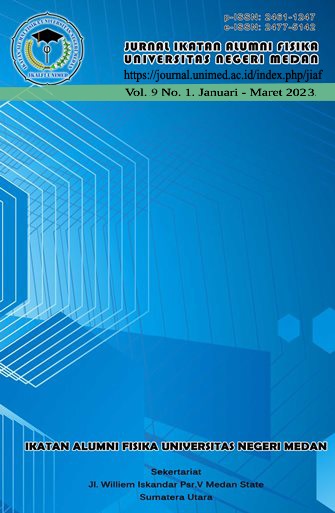PENGEMBANGAN INSTRUMEN TES BERBASIS HIGHER ORDER THINKING SKILLS (HOTS) PADA MATERI GERAK LURUS
DOI:
https://doi.org/10.24114/jiaf.v9i1.32700Keywords:
Gerak Lurus, Tes HOTS, Pengembangan Instrumen TesAbstract
Penelitian ini bertujuan untuk menghasilkan instrument tes berbasis High Order Thiking Skill (HOTS) pada materi gerak lurus yang layak digunakan sebagai evaluasi hasil pembelajaran pada siswa. Subjek pada penelitian ini adalah siswa Kelas X MIA 3 SMA dengan jumlah 30 orang. Jenis penelitian ini menggunakan model Penelitian pengembangan Research and Development (R&D) dan menggunakan desain penelitian ADDIE yang terdiri dari 5 tahapan meliputi (Analysis, Design, Development, Implementation, and Evaluation) . Angket yang digunakan dalam penelitian ini adalah angket validasi ahli dan angket respon siswa. Berdasarkan hasil uji validasi ahli memiliki nilai CVR (Content Validity Rasio) nilai tertinggi yaitu 4 (sangat valid) dan nilai terendah yaitu 1 (tidak valid).Hasil validitas butir memiliki nilai r_(hitung ) tertinggi yaitu 0,95 (Valid), hasil uji reliabilitas memiliki nilai 0,58 (Reliabilitas sedang), hasil pada tingkat kesukaran memiliki nilai 0,8 (tingkat kesukaran mudah), hasil daya beda soal memiliki nilai 0,62 (baik). Hasil uji responden diketahui bahwa sebanyak 70% responden menyatakan setuju instrumen tes ini dikategorikan baik untuk digunakan. Bedasarkan keterangan tersebut, maka kesimpulan dari pengembangan instrument tes berbasis High Order Thiking Skill (HOTS) dikelas x pada materi Gerak Lurus yang dikembangkan peneliti mendapatkan hasil soal yang layak diperoleh 10 soal dan memenuhi persyaratan instrumen yang baik sehingga layak digunakan untuk melatih keterampilan berpikir kritis siswa. This study aims to produce a test instrument based on High Order Thinking Skill (HOTS) on straight motion material that is suitable for use as an evaluation of student learning outcomes. The subjects in this study were students of Class X MIA 3 SMA with a total of 30 people. This type of research uses the Research and Development Research and Development (R&D) model and uses the ADDIE research design which consists of 5 stages including (Analysis, Design, Development, Implementation, and Evaluation). The questionnaires used in this study were expert validation questionnaires and student response questionnaires. Based on the results of the expert validation test, the highest value of CVR (Content Validity Ratio) is 4 (very valid) and the lowest value is 1 (invalid). The results of item validity have the highest r_(count) value of 0.95 (Valid), the reliability test has a value of 0.58 (medium reliability), the results on the difficulty level have a value of 0.8 (easy difficulty level), the results of the differentiating power of the questions have a value of 0.62 (good). The results of the respondent's test are known that as many as 70% of respondents agree that this test instrument is categorized as good to use. Based on this information, the conclusion from the development of a test instrument based on High Order Thinking Skill (HOTS) in class x on the Straight Motion material developed by the researcher obtained 10 questions that deserve to be obtained and meet the requirements of a good instrument so that it is suitable to be used to train students' critical thinking skills.Downloads
Published
2023-06-06
Issue
Section
Articles
License
Copyright (c) 2023 JURNAL IKATAN ALUMNI FISIKA UNIVERSITAS NEGERI MEDAN

This work is licensed under a Creative Commons Attribution 4.0 International License.
Authors who publish with this journal agree to the following terms:- Authors retain copyright and grant the journal right of first publication with the work simultaneously licensed under a Creative Commons Attribution License that allows others to share the work with an acknowledgement of the work's authorship and initial publication in this journal.
- Authors are able to enter into separate, additional contractual arrangements for the non-exclusive distribution of the journal's published version of the work (e.g., post it to an institutional repository or publish it in a book), with an acknowledgement of its initial publication in this journal.
- Authors are permitted and encouraged to post their work online (e.g., in institutional repositories or on their website) prior to and during the submission process, as it can lead to productive exchanges, as well as earlier and greater citation of published work (See The Effect of Open Access).

